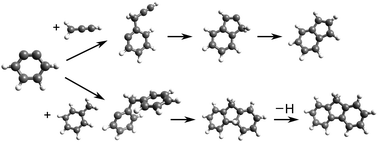Reactions of o-benzyne with propargyl and benzyl radicals: potential sources of polycyclic aromatic hydrocarbons in combustion†
Abstract
The kinetics and mechanisms of the reactions of o-benzyne with propargyl and

* Corresponding authors
a
Department of Chemical System Engineering, School of Engineering, The University of Tokyo, 7-3-1 Hongo, Bunkyo-ku, Tokyo 113-8656, Japan
E-mail:
miyoshi@chemsys.t.u-tokyo.ac.jp
Fax: +81-3-5841-1522
Tel: +81-3-5841-7296
The kinetics and mechanisms of the reactions of o-benzyne with propargyl and

 Please wait while we load your content...
Something went wrong. Try again?
Please wait while we load your content...
Something went wrong. Try again?
A. Matsugi and A. Miyoshi, Phys. Chem. Chem. Phys., 2012, 14, 9722 DOI: 10.1039/C2CP41002H
To request permission to reproduce material from this article, please go to the Copyright Clearance Center request page.
If you are an author contributing to an RSC publication, you do not need to request permission provided correct acknowledgement is given.
If you are the author of this article, you do not need to request permission to reproduce figures and diagrams provided correct acknowledgement is given. If you want to reproduce the whole article in a third-party publication (excluding your thesis/dissertation for which permission is not required) please go to the Copyright Clearance Center request page.
Read more about how to correctly acknowledge RSC content.
 Fetching data from CrossRef.
Fetching data from CrossRef.
This may take some time to load.
Loading related content
